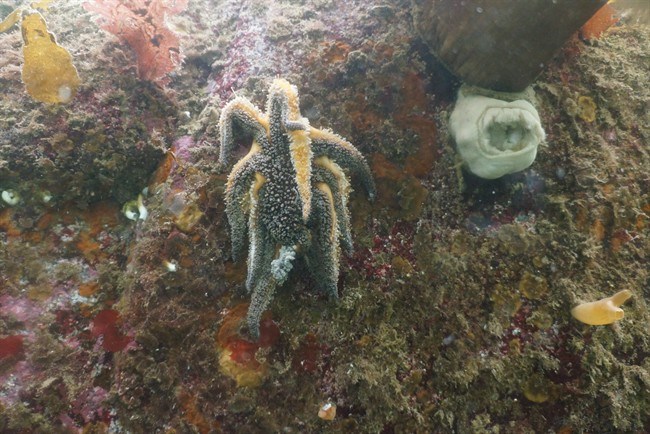VANCOUVER ŌĆö Scientists are making some headway in figuring out what is killing millions of sea stars in the waters off the 91įŁ┤┤ coast, from British Columbia to Mexico.
While a definitive answer eludes them, researchers suggest a pathogen ŌĆö either bacterial or viral ŌĆö is responsible for the death toll.
"We don't have an absolute answer yet," said Lesanna Lahner, a veterinarian at the Seattle Aquarium, after presenting the latest information at the Salish Sea Ecosystem conference in Seattle last week.
"We've narrowed in on it possibly being a pathogen, some sort of infectious source, bacterial or viral."
The disease was first noticed last summer, among sunflower sea stars near 91įŁ┤┤ and Seattle. Within weeks, whole colonies had dissolved into the sea.
White lesions appear on the arms of the sea stars ŌĆö commonly called starfish. Very quickly, they begin to deteriorate until their arms fall off. Eventually, there's nothing left but "goo."
Just gathering specimens for testing was a challenge because the creatures disintegrated so quickly.
Populations of several different species have been wiped. Occurrences have been noted as far north as Sitka Sound, Alaska, but it's more common in British Columbia, where it's been confirmed from Port Hardy in the north and as far south as Montague Harbour, a marine park off Galiano Island, one of the Gulf Islands.
Washington state has many dozens of confirmed sites where the sea stars have wasted away, but Oregon only a handful. The California coast has been decimated.
The 91įŁ┤┤ Northwest, in particular, is renowned for its bright array of sea stars ŌĆö marine invertebrates that weigh up to five kilograms and live from three to five years.
Martin Haulena, staff veterinarian at the 91įŁ┤┤ Aquarium, said ongoing surveillance has revealed the massive extent of the die-off.
A large team of researchers is working on it but they're hesitant to point the figure just yet on a cause.
"I think there's been a lot of progress," he said. "Certainly the microbiology side of things and the molecular biology side of things, the virology side of things have revealed some really interesting findings."
Sunflower sea stars were the first found disintegrating on the ocean floor, but the disease has not been discerning. Morning sun, mottled, giant pink, and purple stars have suffered the highest mortality.
Five more species have also been found dead and scientists believe 10 others are affected but haven't been well-documented.
In the pockets where the syndrome takes hold, mortality is upwards of 95 per cent.
"It's very deadly in the regions where it's happening," said Lahner, whose aquarium is working with the 91įŁ┤┤ Aquarium, ZooPath, Cornell University, U.S. Geological Service, Wildlife Conservation Society, SeaDoc and the Monterey Bay Aquarium to find the answer.
In July, researchers at the University of Rhode Island reported sea stars deaths on the east coast, as well, from New Jersey to Maine. The toll has been much less and scientists aren't sure if the two are related.
There has been much speculation about the cause of the largest ever die-off of the species every documented.
Is it a virus? Warming water due to climate change? Some even blamed radioactive water from the Fukushima nuclear plant disaster in Japan. The Multi-Agency Rocky Intertidal Network, or MARINe, ruled that out in January.
"There has been substantial speculation in the media that the disease could be a result of increased radiation from the nuclear power plant disaster in Fukushima, Japan. We have no evidence to suggest that radiation is a likely culprit," the agency said on its website.
Benjamin Miner, a biologist at Western Washington University, is working with colleagues at Cornell University and others to unlock the secret of the syndrome. They have not yet found the direct cause of the die-offs, he said.
"There is evidence that stars that die have elevated bacterial loads, probably from secondary infections. We have some evidence that a virus is involved, but the results are very preliminary," Miner said.
"Stress likely also plays a role."
It may be part of a natural cycle, he said.
"We currently know so little about the disease that we have no suggestions about how to prevent it," he said.



